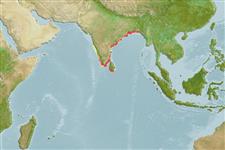Common names from other countries
Environment: milieu / climate zone / depth range / distribution range
Écologie
marin; saumâtre; océanodrome (Ref. 51243); profondeur 0 - 50 m (Ref. 189). Tropical; 25°N - 5°N, 71°E - 94°E (Ref. 189)
Indian Ocean: eastern coasts of India; possibly also Myanmar.
Taille / Poids / Âge
Maturity: Lm ? range ? - ? cm
Max length : 15.5 cm SL mâle / non sexé; (Ref. 189)
Épines dorsales (Total): 0; Épines anales 0; Rayons mous anaux: 38 - 44. Belly with 26 or 27 keeled scutes from isthmus to anus. Tip of snout a little above level of eye center. Maxilla moderate, projecting at most to halfway to pectoral fin base; first supra-maxilla small; angle of mouth rather oblique, teeth of lower jaw slightly enlarged. An indistinct dark blotch behind upper part of gill opening and a faint dark line along back.
Presumably schooling, occurring mostly inshore and entering estuaries and also Lake Chilka in India, thus able to tolerate lowered salinities. More data needed based on correct identifications. If this is the species being referred to in Ref. 6841, then the young feeds on surface plankton, chiefly on prawn larvae, but also small fishes (e.g. Stolephorus) and cypris. Apparently common.
Life cycle and mating behavior
Maturité | Reproduction | Frai | Œufs | Fécondité | Larves
Whitehead, P.J.P., G.J. Nelson and T. Wongratana, 1988. FAO Species Catalogue. Vol. 7. Clupeoid fishes of the world (Suborder Clupeoidei). An annotated and illustrated catalogue of the herrings, sardines, pilchards, sprats, shads, anchovies and wolf-herrings. FAO Fish. Synop. 125(7/2):305-579. Rome: FAO. (Ref. 189)
Statut dans la liste rouge de l'IUCN (Ref. 130435)
CITES (Ref. 128078)
Not Evaluated
Menace pour l'homme
Harmless
Utilisations par l'homme
Pêcheries: intérêt commercial mineur
Plus d'informations
Noms communsSynonymesMétabolismePrédateursÉcotoxicologieReproductionMaturitéFraiFéconditéŒufsDéveloppement de l'œuf
RéférencesAquacultureProfil d'aquacultureSouchesGénétiqueElectrophoresesHéritabilitéPathologiesTraitementMass conversion
CollaborateursImagesStamps, Coins Misc.SonsCiguateraVitesseType de nageSurface branchialeOtolithesCerveauxVision
Outils
Articles particuliers
Télécharger en XML
Sources Internet
Estimates based on models
Preferred temperature (Ref.
115969): 27.5 - 28.6, mean 27.9 (based on 54 cells).
Phylogenetic diversity index (Ref.
82804): PD
50 = 0.5000 [Uniqueness, from 0.5 = low to 2.0 = high].
Bayesian length-weight: a=0.00339 (0.00179 - 0.00640), b=3.08 (2.92 - 3.24), in cm Total Length, based on LWR estimates for this species & Genus-body shape (Ref.
93245).
Niveau trophique (Ref.
69278): 3.5 ±0.50 se; based on food items.
Résilience (Ref.
120179): Haut, temps minimum de doublement de population inférieur à 15 mois (Preliminary K or Fecundity.).
Fishing Vulnerability (Ref.
59153): Low vulnerability (10 of 100).
